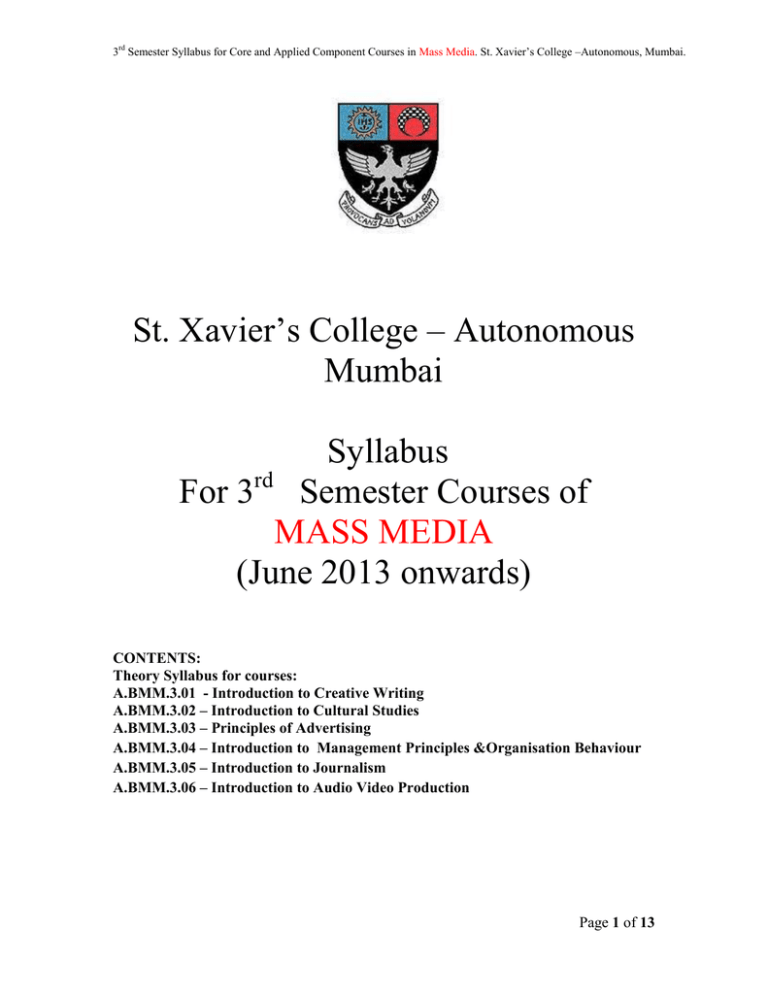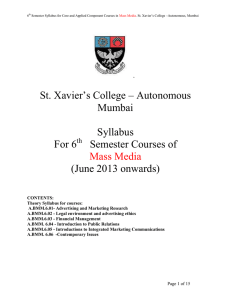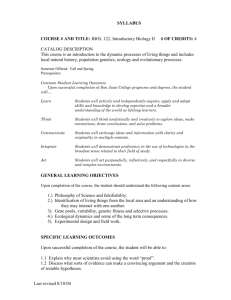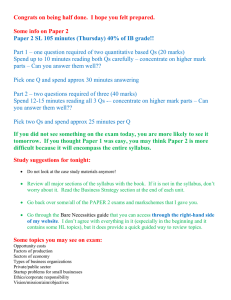Document 10283529
advertisement

3rd Semester Syllabus for Core and Applied Component Courses in Mass Media. St. Xavier’s College –Autonomous, Mumbai.
St. Xavier’s College – Autonomous
Mumbai
Syllabus
For 3rd Semester Courses of
MASS MEDIA
(June 2013 onwards)
CONTENTS:
Theory Syllabus for courses:
A.BMM.3.01 - Introduction to Creative Writing
A.BMM.3.02 – Introduction to Cultural Studies
A.BMM.3.03 – Principles of Advertising
A.BMM.3.04 – Introduction to Management Principles &Organisation Behaviour
A.BMM.3.05 – Introduction to Journalism
A.BMM.3.06 – Introduction to Audio Video Production
Page 1 of 13
3rd Semester Syllabus for Core and Applied Component Courses in Mass Media. St. Xavier’s College –Autonomous, Mumbai.
S.Y.BMM
Course: A.BMM.3.01
Title: Introduction to Creative Writing
No of Lectures: 60
Learning Objective:
Introduce the students to various technical and aesthetic aspects of writing.
Through continuous exercises fine tune their creative writing skills.
1. PLOT
(5)
Using a Sherlock Holmes story, we examine how the manner in which a story is told can
make it interesting. In the process we learn the difference between story and plot.
2. CONFLICT
(5)
Here we look at how two differently placed narratives generate the crucial element of any
good short story: tension or conflict.
3. MOTIFS and THEMES
(5)
A motif can be a situation, character-type, an image or an idea that recurs through works
of literature and is linked to the larger theme of those works. Taking an example each of a
motif and a theme, we will study how texts can make meaning by referring to other texts,
through ―intertextuality.‖
4. CHARACTERIZATION
(5)
In this class, we look at a Chekhov story for the way in which setting, dialogue and
narrative are integrated in the protagonist’s character.
Sub topic- use of interior monologue.
5. SETTING
(8)
W read a story of the fantasy genre and examine how its setting is poeticized through
thematic development.
-Sub topic-Rhythm
6. AESTHETICS: Romanticism to Realism
(8)
Understanding the Romantic and Realist aesthetics: core themes, arche-types, and
linguistic norms with the help of stories by Poe and Mauppassant.
Birth of the modern short story by analyzing a work of Chekhov in comparison with
Mauppassant; understanding how voice and structure changed post Chekhov.
Page 2 of 13
3rd Semester Syllabus for Core and Applied Component Courses in Mass Media. St. Xavier’s College –Autonomous, Mumbai.
7. AESTHETICS: Realism to Modernism
(8)
Discussion on core modernist themes, content, arch-types using the work of James Joyce.
Discussion on pop art and cultural context of art using a short story by Woody Allen.
8. AESTHETICS: Modernism to Post Modernism
(8)
Discussion on core post modernism themes, content, arche-types reading the works of
Jhumpa Lahiri and Yiyun Li.
9. AESTHETICS: New voices
(8)
Challenges in writing about new themes: technology, multi-linguistic cultures,
multiculturalism, globalization reading the works of akpen, murakami and junot diaz.
Audio: New Yorker interview with Junot Diaz and Edwidge Danticat.
Internal Assessment: Research project
Reference Books:
Arco Peterson, S; How to write short stories; Petersons 2002
Axelrod,R.V et al ; The St.Martins Guide to writing; Instructors Resource Manual.
Bell, Julia; The creative writing course book; 40 Authors share advice and exercises for
fiction and poetry.
Page 3 of 13
3rd Semester Syllabus for Core and Applied Component Courses in Mass Media. St. Xavier’s College –Autonomous, Mumbai.
S.Y.BMM
Course: A.BMM.3.02
Title: Introduction to Cultural Studies
No of Lectures: 60
Learning Objectives:
To introduce students to a set of approaches in the study of culture
To question accepted definitions and normative descriptions of culture
To analyse those activities that shape the everyday life of people and
How cultural practices have gained their meanings.
1. Cultural studies ---An Overview
a) Evolution and need to study cultural studies.
b) Examining definitions and theories of culture
(12)
2. Marxism and Culture
a) Central ideas of Marxism
b) Ideology (John Storey-gives 5 approaches)
c) Hegemony- Gramsci
d) Culture industry –Adorno
e) Circuit of culture –Stuart Hall
f) Popular culture and Mass culture –John Fiske
(12)
3. Orientalism and Culture
a) Representation of the east by the west
b) Post-colonial perspective on cultural hegemony
(12)
4 Gender and Culture
a) Gender vs. Sex—Feminist contribution to the study of gender
b) Masculinity – Issues and representation
b) Sexuality and Representation
(12)
5 Popular consumption and representation of Culture
(12)
Ex. sport, body, iconic images, space, films, oral traditions, carnivals, visual culture,
new media cultures,…..
Internal Assessment: Group Project/ Individual Project/ Book Review/ Class Test/
Presentation
References:
1 During Simon –cultural studies reader (articles)
2 Storey John
3 Nayar Pramod –An introduction to cultural studies
4 Reading Culture
5 Lewis, Jeff –Cultural Studies
Page 4 of 13
3rd Semester Syllabus for Core and Applied Component Courses in Mass Media. St. Xavier’s College –Autonomous, Mumbai.
6 Christopher, K, W.—Rethinking cultural studies (mapping culture)
7 Gray, Ann and McGuigan—Studying culture
8 Williams, Raymond—A Vocabulary of culture and society
9 DuGay Paul,--Doing Cultural studies
10 Edgar and Sedgwick; Key concepts in cultural studies
11 Breckenridge –consuming modernity
12 Page, David and Crawley, William—Satellites over south Asia –broadcasting culture
and public interest
13 Subculture
14 Milner, Andrew and Brontt,J -----contemporary cultural theory (c.s and cultural
theory)
15 Corrigan, Peter—Sociology of consumption
16 Featherstone ---Postcolonial cultures
17 McRobbie –uses of cultural studies
18 Literary into Cultural studies
19 Sport, Media and society
20 Nayar, Pramod—packaging life, cultures of the everyday
21 Vishnu, A --Digital culture unplugged
22 MARG publications visual culture
23 Nabar, Vrinda—caste as woman
24 Jose, C –construction Dalit identity
25 Wolf, Naomi –Beauty Myth
Page 5 of 13
3rd Semester Syllabus for Core and Applied Component Courses in Mass Media. St. Xavier’s College –Autonomous, Mumbai.
S.Y.BMM
Course: A.BMM.3.03
Title: Principles of Advertising
No of Lectures: 60
Learning Objectives:
To expose students to various principles of Advertising and Marketing
1.
Behavioral Fundamentals
The Behavior of Consumers
Attitude change – a central theme in advertising
Theories on attitude change
Factors in advertising that accomplish Audience Persuasion
Source/Endorser/Presenter of the message
The message, Rational appeal/Emotional appeal
Background for Advertising
Marketing Fundamentals for Advertisers
Product Identification
Deciding Advertising objectives, budget, media.
(15)
2.
Advertising Management
Advertising Agencies and Departments
Advertising – An Overview
The rise of global agencies
Neo-liberal enterprise culture
Fragmentation and planetary conscience
The new marriage of advertising and fiction
The bestiary of lifestyle culture
The crisis of public culture
Subjectivity of social criticisms of advertising.
Systematic approach to Making of an Advertisement
Lay Out
Copy
Typography, Production and Colour
(15)
3.
Differentiating and Positioning
Value Addition, the Purpose; Differentiation, the Route
Product Lends the Maximum Scope for differentiation
Differentiation on Tangible Product Attributes
It is Differentiations that Builds brands
Positioning: Why is Positioning Important?
The tasks involved in Positioning
(15)
-
Page 6 of 13
3rd Semester Syllabus for Core and Applied Component Courses in Mass Media. St. Xavier’s College –Autonomous, Mumbai.
4.
Managing Brand and Brand Equity
(15)
Role and Significance of Brands
Categorization of Brands based on the type of value they offer
The tasks in developing and managing brands
Selecting the brand elements – brand Name, Logo, slogan…
Brand Extension, Rejuvenation, Re launch, Brand Proliferation Brand Acquisition
Each Brand as SBU
Monitoring the brand through the Stages of Its Life cycle
Understanding Brand Equity
The new demands on today’s Brand Manager
Measuring Advertising effectiveness
Internal Assessment : Group Project/ Individual Project/ Book Review/ Class Test/ Case
Study/ Presentation
References
Advertising International by Armand Mattelart
Syatematic Approach to Advertising Creativity by Stephen Baker
Contemporary Advertising by Wiliam F Arens
Page 7 of 13
3rd Semester Syllabus for Core and Applied Component Courses in Mass Media. St. Xavier’s College –Autonomous, Mumbai.
S.Y.BMM
Course: A.BMM.3.04
Title: Introduction to Management Principles & Organisation Behaviour
No of Lectures: 60
Learning Objectives:
To foster management skills and give them an understanding of organization functions
1. Introduction to management
(10)
What is management?
Management functions
Management levels
Management Consultancy
Early management thought and practice
The Classical management perspective
Quantitative Management perspective and contemporary Management
Perspective
2. The Organization environment model
Organization environments
Organization as systems
Formal Organization; Design and structure
Division of labor and task Interdependence
Specialization of work
Distribution of Authority
(7)
3. Organization culture
Sources of Organization culture
Types of Organizational culture
Manifestation and managing Organization culture
Organizational subcultures
Work force diversity – gender, ethnic and community issues
(8)
4. Motivation
Theories of motivation
Need Theories
Process theories
Application of theories
Job enrichment
Self-directed work group
Job rotation and cross training
Learner management structures
TQM
Positive reinforcement programs
(10)
Page 8 of 13
3rd Semester Syllabus for Core and Applied Component Courses in Mass Media. St. Xavier’s College –Autonomous, Mumbai.
Productivity gain sharing approaches
5.
Motivation and Leadership
Theories and Styles
The Controlling Process
Definitions, Importance and characteristics of effective control
(10)
6.
Groups in Organization and group dynamics
Issues of conformity, social facilitation
Risky shift and polarization
Group cohesion and consequences
Cooperation and competition
Concept of Team work, effectiveness
Stress
Sources of stress – work and non-work factors
(10)
7.
Decision making
Characteristics of decision making process
Ideal vs. Actual decision making
Group think
Decision making in networked organizations
(5)
Internal Assessment: Group Project/ Individual Project/ Book Review/ Class Test/ Case
Study/ Presentation
References:
1. Organizational behaviour by Robbins .S.P.
2. Organization Behaviour by Luthans, Fred
3. Management by Harold Koontz, Heinz Weihrich
4. Management by Stephen .P. Robbins
5. Management by Stoner J.A.F., Freman A.F.,Gilbert D.A.
Page 9 of 13
3rd Semester Syllabus for Core and Applied Component Courses in Mass Media. St. Xavier’s College –Autonomous, Mumbai.
S.Y.BMM
Course: A.BMM.3.05
Title: Introduction to Journalism
No of Lectures: 60
Learning Objectives:
To give students an understanding of the history and development of
Journalism in the global and the Indian context.
Introduce students to concepts related to news and Journalistic practice.
1.
History – from Guttenberg to the Internet; Include print, radio, television and
internet; changing face of the news at international level and how each new
medium has impacted the other and journalism itself. Stages of development
and changing role and how new media is influencing the print media. The rise
of the nationalist Press , Post-Independence Nehruvian era , The Emergency ;
banning of magazine and newspaper, Post- Emergency magazine boom, Post
Globalisation. International Journalism stages of Representative news media of
U.S. , Europe and Asia.
(20)
2.
Types of News Papers: Broadsheet Tabloid , The Role and Functions of
Journalism- Interpretation, Linkage, transmission of values, entertainment,
development; Organization and structure of Media organization : print,
electronic, and special reference to Editorial department.
(15)
3.
Basic Journalistic writing
Formats, News Report, Features, Interviews
(10)
-
Writing for Commercial supplements: Regular and Commercial
-
Focus on writing for Newspaper, Magazine, Television and Radio
4.
Principles/ Canons of Journalism with special reference to the current scenario.
(5)
5.
Current affairs; general knowledge
(10)
A part of internal assessment will be a weekly test on current affairs.
Internal Assessment: / Individual Project/ Book Review/
Page 10 of 13
3rd Semester Syllabus for Core and Applied Component Courses in Mass Media. St. Xavier’s College –Autonomous, Mumbai.
References:
1.
Mencher, Melvin; News Reporting and Writing; 1997 edition; Columbia
University Press.
2.
R.Natrajan; History of Indian Press
3.
Edited by Uday Sahay; Making News
4.
Anne Zaidi; The known Truff
5.
6.
7.
Ed. Boyce, George; Curron, James; Wingate, Pauline; Newspaper History
from the 17th Century to the present day; (1978) ; Sage.
Wilson, John. Understanding Journalism; (1966) ; Routledge
Mazumdar, Aurobindo; Indian Press and Freedom Struggle; (1993); Orient
Longman
Page 11 of 13
3rd Semester Syllabus for Core and Applied Component Courses in Mass Media. St. Xavier’s College –Autonomous, Mumbai.
S.Y.BMM
Course: A.BMM.3.06
Title: Introduction to Audio Video Production
No of Lectures: 60
Learning Objectives:
To acquaint students with the method of film making and production
1.
Introduction
Pre Prod and Post prod
Designations &/or Roles in Productions
Production management Legal & Admin
Budgets, Recce, Permissions & NOCs
(2)
2.
Types of Films
Feature, Short, Satire, Silent, Art
Documentary Films
Corporate Films
Ad Films
Travel & Lifestyle
(3)
3.
Shots and Edit Techniques
Aspect Ratio & Letter Boxing
Establishing
ABC, Continuity, Montage, Stop Motion, Time Lapse
Importance of Sound,VO – BG – FX
Types of Microphones used
Sync. Sound &/or Dubbing
Camera – Platforms & Formats
SD & HD
Film & RED
(10)
4.
Types of Lights
Key – Fill – Back
Relationship of Make Up & Lighting
Lighting for Chroma
Shooting Outdoors (Natural Light)
Day Light
Twilight
Low Light
Royalty Free Music &/or Stock Videos
(10)
Page 12 of 13
3rd Semester Syllabus for Core and Applied Component Courses in Mass Media. St. Xavier’s College –Autonomous, Mumbai.
5.
Understanding Culture & Sub Cultures
Editing
The Art of Story telling and not merely cutting & chopping
Rough Cut – First Cut – Final Cut – Director's Cut
Layers, Transitions, Filters – Ex. Chroma Keying
Sound, Layers, Mixing, Leveling & Mastering
Packaging, Titling & Credits, Sub Titling, Supers, After Effects
(15)
6.
The television script
a. The treatment
b. The two-column script
c. The screenplay format
d. The storyboard
e. Interactive scripts
f. Narration scripts
(10)
7.
Producing the television scripts
(10)
a. The proposal
b. Preproduction
c. Production types of camera shots and movements
d. Post-production linear Vs. Non linear, editing online, offline chroma
e. Audio sweetening
Internal assessment: Group project/ Individual project/ Book review/ Class test
Case study/ Presentation {Power point / Audio ― Visual presentation/ Oral
presentation}
References:
Ed. Bill Nichols; Movies and Method; 2 Volumes, University of California
Gaston Berghes; Chitra Bani; A book on Film Appreciation
Gaston Roberage; The way of Film Studies; Ajanta Publication, 1992
Page 13 of 13





